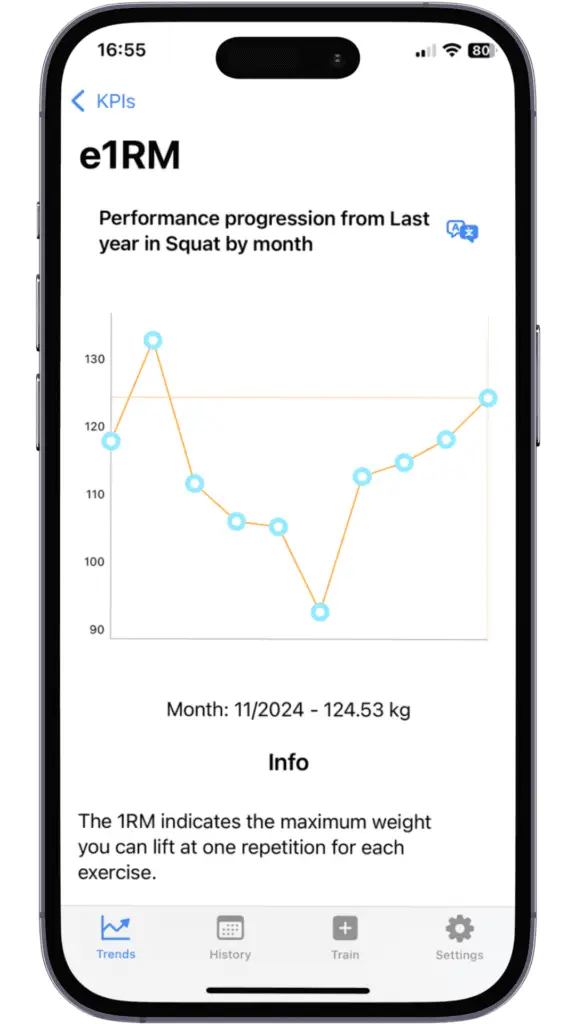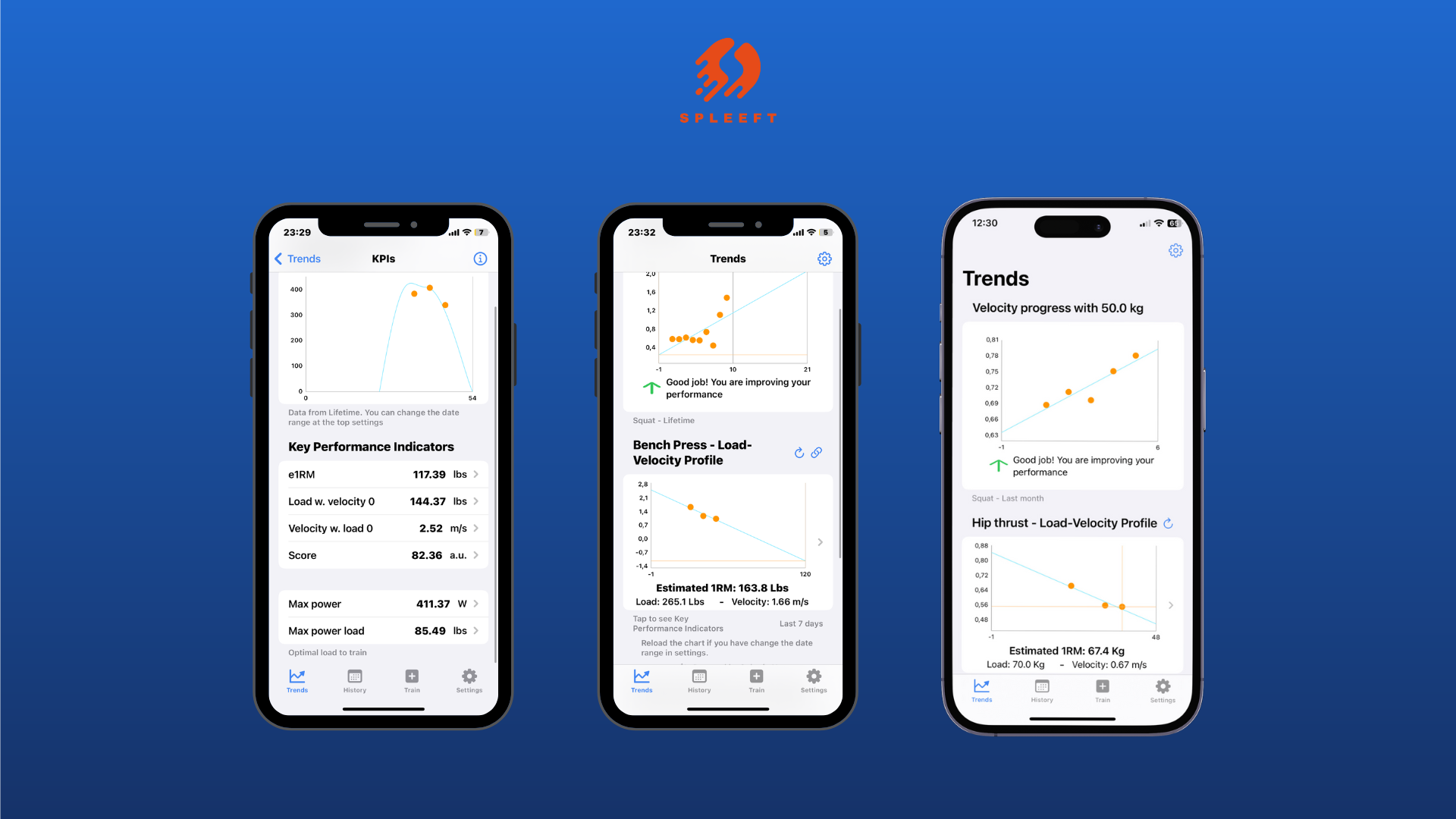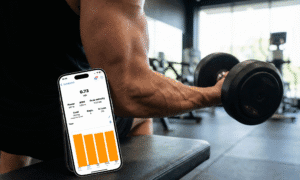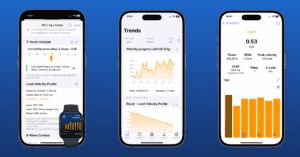In strength training, understanding your 1RM (One Rep Max) is a game changer. Your 1RM max is the heaviest weight you can lift for just one repetition, and it’s crucial to know this number if you want to optimize your training plan. At Spleeft, we believe that everyone, whether you’re a professional athlete or a gym enthusiast, should know how to calculate their rep maximum and track their progress effectively. With the help of modern technology and the right velocity tracker, we can take the guesswork out of estimating your 1RM.
In this post, we’ll walk you through the different ways you can calculate your 1RM max. We’ll also dive into how our app for velocity can help you not only estimate your 1RM, but also monitor your speed and strength over time. Let’s explore the most efficient ways to determine your One Rep Max and make your strength training more effective.
DOWNLOAD SPLEEFT APP NOW FOR PHONE, MAC AND WATCH!
What is 1RM and Rep Maximum? Why Does It Matter?

Knowing your 1RM (One Rep Max) is one of the most important metrics in strength training. It’s the maximum amount of weight you can lift for one complete repetition of a given exercise, such as the squat, deadlift, or bench press. Tracking your 1RM max matters because it sets a benchmark for your strength. Here are a few reasons why this matters:
- Personalized Training Intensity: Your 1RM max helps determine the load for different training phases. Most strength programs base their set and rep schemes on a percentage of your 1RM. If you know your 1RM, you can ensure that you’re lifting the right weight to meet your goals.
- Progress Monitoring: Tracking your rep maximum over time allows you to see whether you’re getting stronger. By periodically testing your 1RM, you can adjust your training intensity and volume to avoid plateaus.
- Prevent Overtraining: Working too close to your 1RM without proper recovery can lead to fatigue and injury. Regularly measuring and adjusting your 1RM max ensures that you’re not overexerting yourself.
How to Track Your 1RM Progress with Spleeft
Tracking your 1RM progress is essential for understanding how your strength evolves over time and ensuring that your training remains effective. With the Spleeft app, monitoring your 1RM is easier and more accurate than ever. Here’s how Spleeft helps you stay on top of your progress:
1. Automated Progress Tracking
Spleeft automatically tracks and logs your 1RM progress for each exercise over time. The app generates clear, easy-to-read graphs that show how your estimated 1RM changes month by month. This helps you identify trends, such as consistent improvement, plateaus, or even periods of regression, allowing you to adjust your training plan accordingly.
2. Real-Time Updates with Velocity Data
Unlike traditional methods that require physically testing your max, Spleeft uses velocity-based training to estimate your 1RM in real-time. By measuring the speed of each lift, the app calculates your estimated 1RM without the need to risk injury by attempting a true maximum lift. This feature ensures you get accurate, actionable data every time you train.
3. Insights into Training Effectiveness
The app’s visualization tools give you a clear picture of how your training program is affecting your strength. For example, you can see if certain phases, such as hypertrophy or strength blocks, are producing measurable gains in your 1RM. This helps you fine-tune your programming to maximize results.
4. Set Goals and Celebrate Milestones
With Spleeft, you can set specific strength goals, such as increasing your squat 1RM by 10 kg in six months. The app keeps you motivated by showing your progress toward these goals, turning every small improvement into a milestone worth celebrating.
5. Safe and Smart Progression
By relying on velocity-based estimates rather than true 1RM tests, Spleeft minimizes the risk of overtraining and injury. You can train confidently, knowing that your progress is tracked safely and effectively.
Use Spleeft’s 1RM tracking feature to monitor your performance like never before. With visual data at your fingertips, you’ll know exactly how far you’ve come and where to focus your efforts next.

Traditional Methods to Measure 1RM
There are various methods to calculate your 1RM in the gym. Below, we’ll explore some of the most commonly used ways, both direct and indirect, and how they can be used safely to find your One Rep Max.
1. Direct 1RM Calculator Testing
This is the most straightforward method and involves lifting the maximum weight you can handle for one repetition. While this provides a precise number, it’s not without risk, especially for beginners. Testing your 1RM max this way is typically reserved for experienced lifters who know how to safely perform heavy lifts.
The process usually involves performing a warm-up, followed by increasing weight until you reach your maximum effort. However, because of the risks involved (potential for injury or fatigue), it’s not always the best option for everyone.
2. 1RM Estimation from Submaximal Reps
If you don’t feel comfortable lifting your maximum weight, you can estimate your 1RM using a formula that calculates it based on how many reps you can complete with a lighter load. This is one of the safest and most popular ways to estimate your rep maximum.
One common equation used is the Epley formula:
1RM=Weight×(1+(0.0333×Reps))1RM = Weight times (1 + (0.0333 times Reps))1RM=Weight×(1+(0.0333×Reps))
For example, if you can lift 200 lbs for 5 reps, your estimated 1RM max would be:
1RM=200×(1+(0.0333×5))=233lbs1RM = 200 times (1 + (0.0333 times 5)) = 233 lbs1RM=200×(1+(0.0333×5))=233lbs
This method is both safer and easier for most people, especially if you’re training alone or don’t want to risk injury from maxing out.
3. 1RM Max Calculator Tools
Many strength athletes rely on 1RM Max calculators to do the heavy lifting (pun intended) of determining their max. A 1RM calculator uses formulas similar to the ones mentioned and can estimate your One Rep Max based on the weight and reps performed. At Spleeft, our app incorporates an advanced 1RM calculator within our velocity tracker to help estimate your max weight based on real-time data.
Our app for velocity calculates your 1RM max based on the speed at which you move a given weight, so you don’t need to put yourself at risk by attempting a true max lift. This makes it an ideal solution for anyone looking to safely improve their performance.
Estimating 1RM From Multiple Rep Sets: 10RM to 1RM
If you have your 10RM (10 Rep Max), you can use it to estimate your 1RM. Many people prefer testing higher rep ranges like 10RM instead of the 1RM max for safety and practicality reasons. Converting your 10RM to 1RM is relatively simple with a formula similar to those mentioned earlier, or by using conversion tables.
To estimate 1RM from 10RM, you can again use the Epley formula or a conversion chart. The conversion for 10RM to 1RM would look something like this:
If you lift 150 lbs for 10 reps:
1RM=150×(1+(0.0333×10))=199lbs1RM = 150 times (1 + (0.0333 times 10)) = 199 lbs1RM=150×(1+(0.0333×10))=199lbs
This method is popular because it’s safer, and lifting for higher reps reduces the risk of injury.
The Role of Velocity in 1RM Calculation

Velocity-based training (VBT) has changed the game when it comes to measuring strength. The speed at which you move a weight can be a key indicator of your max strength, and this is where Spleeft truly shines. By using our app for velocity, we can track your barbell speed and estimate your 1RM max without the need to max out in the traditional sense.
In velocity-based training, there’s a clear relationship between the load and the velocity at which the weight is moved. As the load increases, the speed of movement decreases. This relationship can be plotted to form a load-velocity profile, and using this data, we can predict your One Rep Max with remarkable accuracy.
How Spleeft’s Velocity Tracker Works
Our velocity tracker measures the speed of each rep and logs this data to help create a detailed load-velocity profile for every exercise. Based on the fastest rep you perform with any load, we estimate the 1RM max and provide feedback on how to adjust your training. It’s a smarter, data-driven approach to training that helps athletes make real-time decisions in the gym.
By tracking both speed and strength, you’re not only able to calculate your rep maximum but also optimize your power output and avoid burnout.
How to Create a Load-Velocity Profile
Creating a load-velocity profile is essential for understanding the relationship between the weight lifted and the speed of execution, which allows you to estimate key metrics like your 1RM and optimize your performance. Here are the basic steps to do it with Spleeft:
- Select an Exercise: Choose a movement like squats, bench press, or deadlifts.
- Record Velocities: Use Spleeft’s velocity tracker to log the speed of your fastest repetition with different weights.
- Graph the Data: The app will automatically generate an inverse curve showing how velocity decreases as load increases.
- Analyze and Adjust: Based on the generated profile, Spleeft will estimate your 1RM and provide key insights, such as your maximum velocity and optimal working load.
Other Key Metrics to Track Your Strength Performance
Beyond 1RM, there are other crucial metrics you can monitor to measure and improve your performance. One of the most important is maximum power load, which indicates the weight at which you achieve maximum power. This is particularly useful for:
- Planning Effective Workouts: Knowing the optimal load to start with for maximizing power.
- Avoiding Constant 1RM Tests: A less demanding and safer metric to track progress.
- Improving Explosive Sports Performance: Ideal for athletes who need to combine strength and speed.
With Spleeft, you can identify this load and adjust your training to stay within your maximum power range, optimizing every session.
Alternative Methods for Measuring Strength in the Gym
While traditional 1RM calculators and velocity-based methods are popular, there are other ways to estimate strength without using a 1RM max or rep maximum. Let’s explore a few:
1. Velocity-Based Training
We’ve already mentioned how velocity trackers can estimate 1RM based on the speed of movement. This method is incredibly effective because it allows you to train safely while still gaining valuable insights into your performance. It’s particularly useful for athletes who want to avoid maxing out, but still need a reliable way to estimate their 1RM max.
2. Repetition Prediction with Lighter Loads
Another method involves lifting lighter loads to failure and using that number to predict your 1RM. While this method isn’t as precise as velocity-based training, it’s still a good way to approximate your strength levels without risking injury.
3. Power-Based Testing
For explosive lifts, such as Olympic lifts or plyometrics, measuring power output can provide another dimension of strength testing. Although not directly related to 1RM, these tests can give you an idea of how much weight you could potentially lift, especially for athletes training for speed and power.
Benefits of Calc 1RM with Spleeft
At Spleeft, we believe that using technology to track your progress is the future of strength training. With our app for velocity, you not only get real-time data on your lifts but also precise calc 1RM for you. Here are a few benefits of using Spleeft for your training:
- Safety: By relying on speed data rather than lifting to failure, you can reduce the risk of injury.
- Precision: Our 1RM calculator uses cutting-edge algorithms to provide accurate results based on your unique load-velocity profile.
- Progress Monitoring: You can track your progress over time and see how your strength is improving.
- Efficiency: You’ll know exactly how much weight to lift each day, avoiding unnecessary fatigue and maximizing gains.
Conclusion
Understanding and calculating your 1RM max is key to getting the most out of your strength training program. Whether you prefer using traditional methods, 1RM calculators, or more advanced tools like a velocity tracker, the important thing is to have accurate data on your strength levels.
At Spleeft, we’re committed to helping you reach your goals with precision and safety. Our app for velocity allows you to estimate your rep maximum with ease, track your performance, and make smarter decisions in the gym. Start using Spleeft today, and take control of your training like never before.





